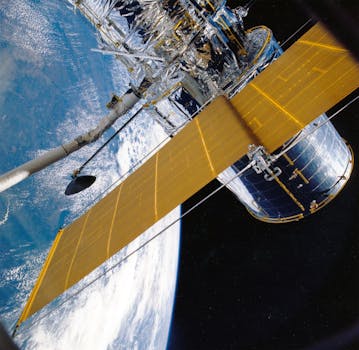From Geostationary to Low Earth Orbit: The Evolution of Satellite Telecommunications in 2023

From Geostationary to Low Earth Orbit: The Evolution of Satellite Telecommunications in 2023
Satellite telecommunications, Geostationary to Low Earth Orbit, have revolutionized the way we communicate and access information. The industry has experienced tremendous growth and innovation, driven by advancements in space technology and changing user demands. In this article, we will explore the evolution of satellite telecommunications, from traditional geostationary orbits to the emerging low Earth orbit constellations, and their implications for the future of global connectivity.
The geostationary orbit, approximately 36,000 kilometers above the equator, has been the backbone of satellite telecommunications for decades. Geostationary satellites, such as Intelsat and SES, have provided a wide range of services, including television broadcasting, telecommunications, and weather forecasting. However, these satellites have limitations, such as high latency, limited bandwidth, and high operational costs. The shift towards low Earth orbit constellations, typically between 160 and 2,000 kilometers above the Earth, is addressing these limitations and opening up new opportunities for the industry.
Low Earth orbit constellations, such as those developed by OneWeb, SpaceX, and Amazon’s Kuiper Systems, consist of hundreds or thousands of small satellites that work together to provide global coverage. These constellations offer several advantages over traditional geostationary satellites, including lower latency, higher bandwidth, and lower operational costs. Low Earth orbit satellites are also more suitable for IoT applications, such as tracking and monitoring, due to their lower power requirements and faster data transmission rates.
The Benefits of Low Earth Orbit Constellations
Low Earth orbit constellations have several benefits that make them an attractive option for satellite telecommunications. One of the primary advantages is lower latency, which is critical for real-time applications such as video conferencing and online gaming. Low Earth orbit satellites have a much shorter distance to travel, resulting in latency as low as 20-30 milliseconds, compared to the 600-800 milliseconds experienced with geostationary satellites. Additionally, low Earth orbit constellations can provide higher bandwidth and faster data transmission rates, making them suitable for applications that require high-speed data transfer, such as cloud computing and big data analytics.
Another significant benefit of low Earth orbit constellations is their ability to provide global coverage, including in remote and underserved areas. These constellations can offer connectivity to areas where traditional telecommunications infrastructure is limited or non-existent, such as in rural or developing regions. This can have a significant impact on bridging the digital divide and providing access to essential services such as education, healthcare, and financial inclusion.
Challenges and Opportunities for the Industry
The shift towards low Earth orbit constellations also presents several challenges and opportunities for the satellite telecommunications industry. One of the primary challenges is the need for significant investment in new infrastructure, including the development and launch of new satellites, as well as the establishment of ground stations and networking infrastructure. Additionally, the industry must also address regulatory and spectrum management issues, as the increasing number of satellites in low Earth orbit raises concerns about congestion and interference.
Despite these challenges, the shift towards low Earth orbit constellations also presents significant opportunities for innovation and growth. The development of new satellite constellations is driving advancements in space technology, such as the use of 3D printing and artificial intelligence in satellite manufacturing. The industry is also experiencing a surge in new entrants, including startups and private companies, which are bringing new ideas and approaches to the market. Furthermore, the increasing demand for satellite-based services, such as IoT and big data analytics, is creating new revenue streams and business models for the industry.
Conclusion
In conclusion, the evolution of satellite telecommunications from geostationary to low Earth orbit is a significant development that is transforming the industry. The benefits of low Earth orbit constellations, including lower latency, higher bandwidth, and global coverage, make them an attractive option for a wide range of applications, from IoT and big data analytics to telecommunications and broadcasting. While the industry faces challenges and opportunities, the shift towards low Earth orbit constellations is driving innovation and growth, and is poised to play a critical role in shaping the future of global connectivity.






